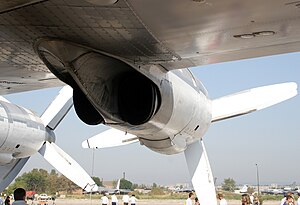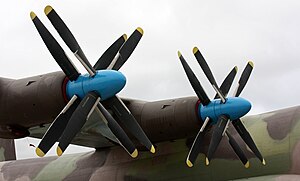Kuznetsov NK-12: Difference between revisions
Strak Jegan (talk | contribs) |
Strak Jegan (talk | contribs) |
||
| Line 27: | Line 27: | ||
The design that eventually became the NK-12 turboprop was developed after [[World War II]] by a team of Russian scientists and deported German engineers under [[Ferdinand Brandner]], who had worked for [[Junkers]] previously; the design bureau was headed by chief engineer Kuznetsov. Thus, the NK-12 design evolved from late-war German turboprop studies. This started with the postwar development of the wartime [[Junkers Jumo 022|Jumo 022]] turboprop design that developed 6000 [[Horsepower#Shaft horsepower|eshp]] in a 3000 kg engine. The effort continued with a 5000 ehp engine that weighed in at 1700 kg, completed by 1947. The evolution to the TV-12 12000 Ehp engine required extensive use of new Soviet-developed alloys and was completed in 1951.<ref>[http://www.janes.com/articles/Janes-Aero-Engines/Kuznetsov-NK-12-Russian-Federation.html Kuznetsov NK-12 (Russian Federation) - Jane's Aero-Engines<!-- Bot generated title -->]</ref> |
The design that eventually became the NK-12 turboprop was developed after [[World War II]] by a team of Russian scientists and deported German engineers under [[Ferdinand Brandner]], who had worked for [[Junkers]] previously; the design bureau was headed by chief engineer Kuznetsov. Thus, the NK-12 design evolved from late-war German turboprop studies. This started with the postwar development of the wartime [[Junkers Jumo 022|Jumo 022]] turboprop design that developed 6000 [[Horsepower#Shaft horsepower|eshp]] in a 3000 kg engine. The effort continued with a 5000 ehp engine that weighed in at 1700 kg, completed by 1947. The evolution to the TV-12 12000 Ehp engine required extensive use of new Soviet-developed alloys and was completed in 1951.<ref>[http://www.janes.com/articles/Janes-Aero-Engines/Kuznetsov-NK-12-Russian-Federation.html Kuznetsov NK-12 (Russian Federation) - Jane's Aero-Engines<!-- Bot generated title -->]</ref> |
||
The NK-12M developed 8,948 kW (12,000 ehp), uprated in the NK-12MV to 11,033 kW (14,795 ehp) and reaching 11,185 kW (15,000 ehp) in the NK-12MA. The NK-12 remains the most powerful turboprop engine ever built. The [[Progress D-27]] and [[Europrop TP400]] came close to this only recently. It powered the [[Tupolev Tu-95]] [[bomber]] and its descendants such as the [[Tupolev Tu-142|Tu-142]] [[maritime patrol aircraft]] and the [[Tupolev Tu-114]] [[airliner]] (with NK-12MV), which is still the world's [[fastest propeller-driven aircraft]] (despite the fact that all Tu-114s have been retired). It also powered the [[Antonov An-22]] Antei (with NK-12MA), the world's largest aircraft at the time, and several types of amphibious assault craft, such as the [[A-90 Orlyonok]] "[[Ground effect vehicle|Ekranoplan]]" |
The NK-12M developed 8,948 kW (12,000 ehp), uprated in the NK-12MV to 11,033 kW (14,795 ehp) and reaching 11,185 kW (15,000 ehp) in the NK-12MA. The NK-12 remains the most powerful turboprop engine ever built. The [[Progress D-27]] and [[Europrop TP400]] came close to this only recently. It powered the [[Tupolev Tu-95]] [[bomber]] and its descendants such as the [[Tupolev Tu-142|Tu-142]] [[maritime patrol aircraft]] and the [[Tupolev Tu-114]] [[airliner]] (with NK-12MV), which is still the world's [[fastest propeller-driven aircraft]] (despite the fact that all Tu-114s have been retired). It also powered the [[Antonov An-22]] Antei (with NK-12MA), the world's largest aircraft at the time, and several types of amphibious assault craft, such as the [[A-90 Orlyonok]] "[[Ground effect vehicle|Ekranoplan]]". |
||
The engine has a 14-stage axial-flow compressor, producing compression ratios between 9:1 to 13:1 depending on altitude, also controlled by variable inlet guide vanes and blowoff valves. The combustion system used is a cannular-type: each flame tube is centrally mounted on a downstream injector that ends in an annular secondary region. The contra-rotating propellers and compressor are driven by the five-stage axial turbine. Mass flow is 65 kg (143 lb) per second.<ref name=autogenerated1>[http://www.airpages.ru/eng/ru/troph3.shtml Creation of the TV-2 (NK-12) turboprop engine<!-- Bot generated title -->]</ref> |
The engine has a 14-stage axial-flow compressor, producing compression ratios between 9:1 to 13:1 depending on altitude, also controlled by variable inlet guide vanes and blowoff valves. The combustion system used is a cannular-type: each flame tube is centrally mounted on a downstream injector that ends in an annular secondary region. The contra-rotating propellers and compressor are driven by the five-stage axial turbine. Mass flow is 65 kg (143 lb) per second.<ref name=autogenerated1>[http://www.airpages.ru/eng/ru/troph3.shtml Creation of the TV-2 (NK-12) turboprop engine<!-- Bot generated title -->]</ref> |
||
Revision as of 15:02, 27 June 2017
| NK-12 | |
|---|---|

| |
| NK-12M Turboprop engine on a Tu-95 at RIAT Fairford 1993 | |
| Type | Turboprop |
| National origin | Soviet Union |
| Manufacturer | Kuznetsov Design Bureau |
| Major applications | Antonov An-22 Tupolev Tu-95 Tupolev Tu-114 |


The Kuznetsov NK-12 is a Soviet turboprop engine of the 1950s, designed by the Kuznetsov design bureau. It drives two large four-bladed (eight per engine) contra-rotating propellers, 5.6 m (18 ft; 4.5 in) in diameter, and 6.2 m (20 ft; 4.1 in) in the NK-12MA and NK-12MV. It is the most powerful turboprop engine ever built.[1]
Design and development
The design that eventually became the NK-12 turboprop was developed after World War II by a team of Russian scientists and deported German engineers under Ferdinand Brandner, who had worked for Junkers previously; the design bureau was headed by chief engineer Kuznetsov. Thus, the NK-12 design evolved from late-war German turboprop studies. This started with the postwar development of the wartime Jumo 022 turboprop design that developed 6000 eshp in a 3000 kg engine. The effort continued with a 5000 ehp engine that weighed in at 1700 kg, completed by 1947. The evolution to the TV-12 12000 Ehp engine required extensive use of new Soviet-developed alloys and was completed in 1951.[2]
The NK-12M developed 8,948 kW (12,000 ehp), uprated in the NK-12MV to 11,033 kW (14,795 ehp) and reaching 11,185 kW (15,000 ehp) in the NK-12MA. The NK-12 remains the most powerful turboprop engine ever built. The Progress D-27 and Europrop TP400 came close to this only recently. It powered the Tupolev Tu-95 bomber and its descendants such as the Tu-142 maritime patrol aircraft and the Tupolev Tu-114 airliner (with NK-12MV), which is still the world's fastest propeller-driven aircraft (despite the fact that all Tu-114s have been retired). It also powered the Antonov An-22 Antei (with NK-12MA), the world's largest aircraft at the time, and several types of amphibious assault craft, such as the A-90 Orlyonok "Ekranoplan".
The engine has a 14-stage axial-flow compressor, producing compression ratios between 9:1 to 13:1 depending on altitude, also controlled by variable inlet guide vanes and blowoff valves. The combustion system used is a cannular-type: each flame tube is centrally mounted on a downstream injector that ends in an annular secondary region. The contra-rotating propellers and compressor are driven by the five-stage axial turbine. Mass flow is 65 kg (143 lb) per second.[3]
Applications
- A-90 Orlyonok
- Antonov An-22
- Tupolev Tu-95
- Tupolev Tu-126
- Tupolev Tu-142
- Tupolev Tu-114
- Tupolev Tu-116
Specifications
General characteristics
Components
Performance
- Maximum power output: 11,033 kW (14,795 ehp), for NK-12MV
- Overall pressure ratio: 9.5[3]
- Turbine inlet temperature: 1250K[3]
- Specific fuel consumption: 0.360 lb/shp-hr [4] 0.219 kg/kW-hr for NK-12MA and NK-12MV
- Power-to-weight ratio: 3.7 kW/kg (2.3 hp/lb), for NK-12MV
See also
Related lists
References
- ^ Tewari A. Atmospheric and Space Flight Dynamics: Modeling and Simulation with MATLAB® and Simulink®. Springer Science & Business Media. 2007. P. 272
- ^ Kuznetsov NK-12 (Russian Federation) - Jane's Aero-Engines
- ^ a b c d e f g Creation of the TV-2 (NK-12) turboprop engine
- ^ Civil Turboshaft/Turboprop Specifications
External links
| This aircraft engine article is missing some (or all) of its specifications. If you have a source, you can help Wikipedia by adding them. |
